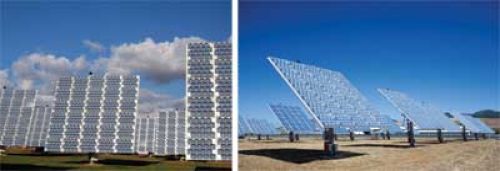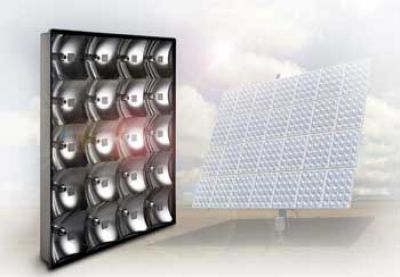 Concentrator PV: Harvesting More, Spending LessCPV technology has clearly moved out of the lab and prototyping phase -- becoming a reality with multi-megawatt installations underway. Sept 8, 2009 - Nancy Hartsoch - Renewable Energy World.COM Today we are faced with dramatically increasing electricity demand globally presenting a critical need for clean, renewable energy. While the sun is the world's most abundant renewable resource, today it is barely tapped as an energy source. The challenge has been in cost effective conversion of that sunlight to electricity. Historically, harvesting photons has been hindered by high costs compared with traditional energy.
Photovoltaics technology (PV) has played a critical role in the evolution of renewable energy. The important thing to recognize, however, is that for the PV industry to reach its growth potential and become a major source of the world’s energy supply, then technology cannot stand still. Technologies like silicon PV and thin films must continue to evolve, working to squeeze more energy out of PV cells, and driving to lower cost. But that alone won’t take us far enough. There is a need for disruptive technologies that leverage existing technology, but are more advanced at providing benefits not achievable with current technologies. Enter…concentrator PV (CPV) CPV is a young technology but the progress made in the past three years alone has been dramatic. In this short time, the number of companies developing CPV systems has grown from a handful to three dozen. The number of companies advancing technology for high-efficiency cells is accelerating, and commercial deployments have gone from a few kilowatts of primarily test sites, to somewhere around 5–8 MW in 2008. The expected deployments this year are forecasted to be between 30–50 MW. CPV now has a place under the sun. High Solar Resource Regions In areas where the solar resource is high, CPV systems are ideal, including such areas as southern Europe, the southwest U.S., Africa, Australia, parts of Latin America and Asia. We estimate that CPV is ideally suited to about one-third of the world’s land regions, which represent ~40% of the world’s population. In these regions, CPV technology will provide the highest level of energy production and the lowest cost of electricity. Low Cost Driven by High Efficiency CPV has been challenged by some as being too expensive a technology. There are two key factors to understand related to cost. First is efficiency. The single biggest impact on the cost of delivering solar energy is efficiency of the system — in other words, the rate at which the system can convert sunlight to electricity. CPV clearly has the highest efficiency levels — nearly twice that of most PV. Of equal importance is the fact that these efficiency levels are increasing on a steady upward trajectory, with tremendous headroom before they begin to approach any theoretical limits for the cell technology.
The second factor is the issue of manufacturing costs. From a volume manufacturing perspective, CPV is in its infancy. The manufacturing cost reduction curve, resulting from rapidly increasing volumes combined with automation, is also moving at a very steep trajectory downward. When you combine the increasing efficiency and decreasing manufacturing costs, CPV clearly leads the industry in its cost of energy reduction potential. CPV Technology: Scalability and Big Solar From a scalability standpoint, there are two key factors to understand. First, CPV systems use very little specialized PV material. The majority of the system is built from readily available materials that can be sourced globally including aluminum and glass. The materials supply shortages that have plagued the solar industry in the past are much less of an issue for CPV, allowing for very rapid scalability from a materials perspective. CPV also has a much lower cap-ex requirement than other solar technologies. This is a very important element of rapidly building capacity as the deployment of CPV systems moves from 8 MW to 50 MW to gigawatts of capacity in the not-so-distant future. CPV provides deployment flexibility from small sites to large utility-scale power plants, with projects being deployed for commercial, industrial, and utility customers in both on-grid and off-grid environments.
High-temperature performance. While it would be easy to assume that high solar resource regions are ideal for all solar, that is not the case. When it gets hot, silicon PV and thin films both suffer temperature degradation, resulting in a much lower energy production as temperature rises. On the contrary, the multi-junction cells used in CPV systems do not suffer from significant temperature degradation. Energy producers get the highest energy output per megawatt installed with CPV. Higher energy production directly correlates to lower cost of energy. Environmental sustainability. CPV uses significantly less PV material than traditional photovoltaics. It depends on the system, but in the case of SolFocus (Fig. 1), its systems are over 97% recyclable. Being mounted on trackers (Fig. 2), not directly on the ground, the systems do not disrupt the land as much as other technologies do. Dual-use of the land is possible; land could be improved while producing energy. CPV also offers a much shorter energy payback than other solar technologies. While it varies depending on the system, energy payback is 6 months for reflective CPV technology like SolFocus’, compared to 2 years for traditional PV. Also important: CPV does not use water to produce electricity. In many high solar resource regions, water is in scarce supply. With technologies such as concentrating solar power, says a National Renewable Energy Laboratory (NREL) report, power plants consume on average 750–1000 gallons/MWh of energy production. ConclusionCPV solutions are changing the face of PV. Deployment of ground mounted, utility scale systems is growing. The cost of solar energy in the fastest growing solar markets is reducing rapidly. The environment is benefiting not just from clean energy, but from energy created with a very small carbon footprint. The technology has clearly moved out of the lab and prototyping phase, and is becoming a reality with multi-megawatt installations underway. Nancy Hartsoch received her MBA from San Jose State U., is chairman/director of the CPV Consortium, and is VP of marketing at SolFocus Inc., Mountain View, CA. This article was reprinted with permission from Photovoltaics World as part of the PennWell Corporation Renewable Energy World Network and may not be reproduced without express written permission from the publisher. Sidebar: CPV Basics Concentrator PV systems convert sunlight directly to electricity, just as other photovoltaic technologies do, but with some important differences.
First, CPV systems use different PV cell technology. CPV systems utilize high-efficiency, multi-junction cells, not silicon. These cells provide over twice the conversion efficiencies of most silicon cells—approaching 40+%. Thus, the amount of photovoltaic material used is a fraction of that used in traditional PV systems. Second, CPV systems use optical elements — mirrors or lenses — to collect and focus sunlight onto these high-efficiency cells. In the optical system shown in the figure at the top of the page, the primary mirror collects the sunlight, focuses it on the secondary mirror, then it travels down the optical rod, concentrating it 650 times onto the high efficiency cell. Similar to a telescope, the CPV optics are trained on the sun’s position and collect and concentrate light onto the solar cell. Third, CPV systems incorporated precision, dual-axis tracking to keep the concentrators in alignment with the sun throughout the day. By tracking the sun from sunrise to sunset, CPV systems produce energy at a steady rate throughout the day and power production remains at high levels during afternoon’s peak demand hours.
|
Updated: 2003/07/28


 By replacing expensive PV material with comparatively inexpensive optics, utilizing high efficiency PV cells, and tracking the sun, energy generation potential is much higher and cost of energy much lower than with other solar technologies in the high solar resource regions of the world.
By replacing expensive PV material with comparatively inexpensive optics, utilizing high efficiency PV cells, and tracking the sun, energy generation potential is much higher and cost of energy much lower than with other solar technologies in the high solar resource regions of the world.